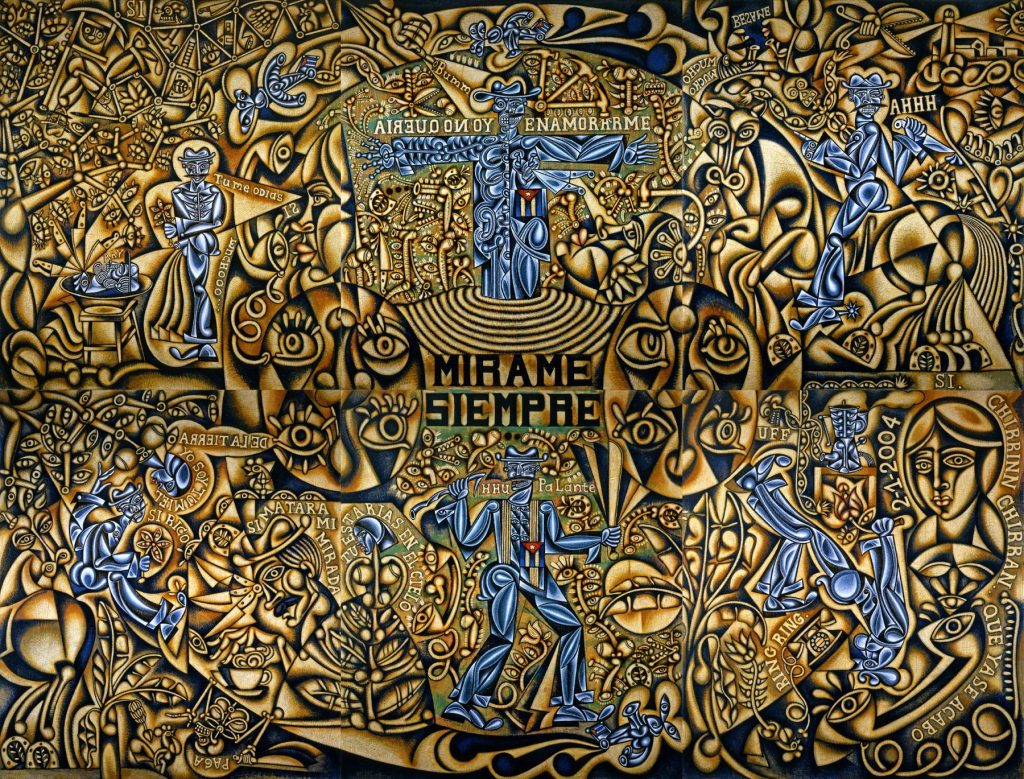El Gran Mambo
by Carlos Luna

Oil on Canvas
Six Pieces Combined
144 x 192 in
(366 x 488 cm)
2006
Provenance
CCG Art Collection, Miami, Florida, USA.
Exhibited
Complejo Cultural Universitario, Puebla, Mexico, August 18, 2009 –
Museum of Art Fort Lauderdale, Nova Southeastern University, Fort Lauderdale, Florida, USA, October 2, 2008 –
Museum of Latin American Art (MOLAA), Long Beach, California, USA, June 12 –
The Katzen, American University Museum, College of Arts and Sciences, Washington, D.C., USA, January 29 –
Polk Museum of Art, Lakeland, Florida, USA, August 24 –
Susquehanna Art Museum, Harrisburg Pennsylvania, USA, January 11 –
Literature
Carlos Luna, Personal Histories, Susquehanna Art Museum, Polk Museum of Art & The Suzanne H. Arnold Gallery, Lebanon Valley College, p. 44 –
Carlos Luna, El Gran Mambo, American University Museum, Museum of Latin American Art (MOLAA), p. 44 –
Pablo Picasso Ceramics, Carlos Luna Paintings, p. 105 –
Museum Description
Carlos Luna
El Gran Mambo
Viewers standing before Carlos Luna’s El Gran Mambo… will confront a very clear order telling them what they must do. In Spanish, the text reads “MIRAME SIEMPRE;” in English, that command might be rendered literally as “LOOK AT ME ALWAYS,” but more colloquially one would say “KEEP YOUR EYES ON ME.” This command is written at the center of his six contiguous sections of extremely diverse images that make up a painting on the scale of a large mural. Indeed, El Gran Mambo is the summa of Luna’s work so far. Technically, pictorially, and conceptually, the painting fuses autobiography and artistic “stand,” and it renders the artist’s particular aesthetic in a single monumental ideogram. The figures and graphic characters that appear in this work are found in Luna’s entire oeuvre, and so the painting-
But why “gran mambo” — Big Mambo — and not, for example, “gran salsa”? Why one musical genre instead of another? For those of us who read the titles of many of Luna’s paintings and the texts that appear within them, it’s no secret that Carlos Luna is more than a mere fan of Cuban and Antillean music of the people. He is a connoisseur and a scholar of African-
The “mambo” that the unforgettable Pérez Prado introduced to the world in 1951, after a decade of musical experimentation — in his likewise unforgettable recording of Qué rico el mambo — has a longer tradition, and a nobler musical and folkloric ancestry, than the salsa. “Mambo” is a word in the Bantu language of Africa that means “conversation with the gods,” and it points to the drums used in religious rituals. Thus, in its references to music, history, and the worship of the African gods, “mambo” is profoundly linked to Carlos Luna’s Afro-
–

